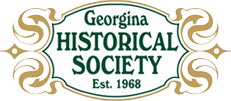Click to Download the PDF
Download the Word Doc
President’s Welcome
April is flying by, the ice is slowly going away on Lake Simcoe, and we’ll soon be complaining that it’s too hot! It’s been a strange winter for the ice on the lake, with the ice coming in late after an exceptionally warm fall, then hanging on longer than usual after an unusually cold March. Although COVID is still lurking in the bushes, it seems we’ve come to terms with it and things are getting back to quasi-normal. The COVID shut down has affected a lot of our institutions, including the Georgina Historical Society, but we’re looking forward to activities in the Georgina Pioneer Village like Music in the Streets being held on June 24 and Harvestfest, coming in September.
Harvestfest, planned and co-ordinated by the Georgina Historical Society, is our big event of the year, and if you would like to get involved as a volunteer, participant or vendor, please contact a member of the GHS board. But, coming up sooner than that, we’re looking forward to our general meeting being held on the evening of April 18th. Lynda Quirino of the Georgina Paranormal Society will be giving a presentation at the new schoolhouse at the Georgina Pioneer Village, and it should be an interesting event. As always, lug a full mug of your favourite beverage and we’ll have some snacks and bottled water available. This will be a presentation you won’t want to miss, and I’m looking forward to seeing you all at the schoolhouse.
Historic Churches of Georgina
By Kim Brady
St. George’s Church at Sibbald’s Point is one of the most photographed churches in the area. It has appeared on postcards from the early days of the 20th century, with photos taken from every viewpoint. The progression of postcards shows the changes in the church cemetery as headstones and markers are added and provides photographic documentation of the church structure as the top of the bell tower is in the earlier postcards but gone in the later ones.
The following is taken from the Parish of Georgina website https://www.parishofgeorgina.org/
St. George’s Anglican Church, Sibbald Point
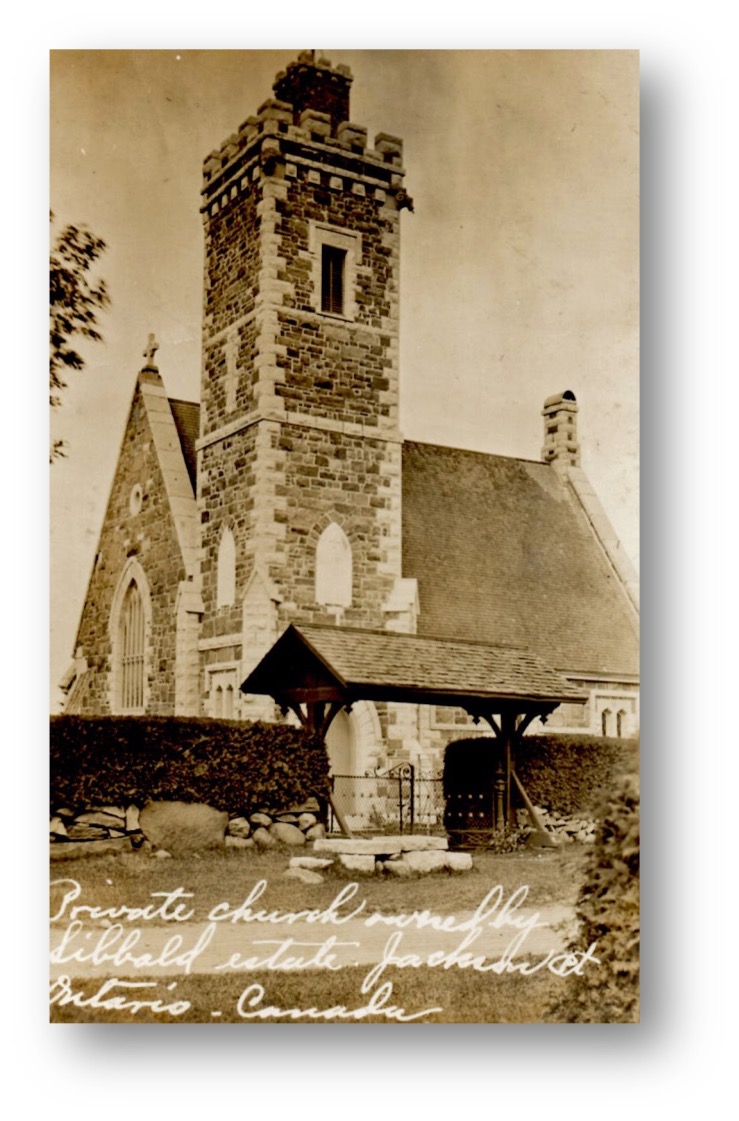
“We the undersigned inhabitants of the Township of Georgina humbly beg leave to your Excellency that at present we are without any place of public worship, burial grounds or school house”.
This 1834 appeal to the Lieutenant Governor of Upper Canada expressed the spiritual longing of the settlers. It arose as they built their homesteads along the south shore of Lake Simcoe. These settlers had been holding Sunday services in their homes for some time.
Even this entreaty did not bring results. However, the local people at considerable personal sacrifice, aided by donations from English and Scottish benefactors, finished the wood and plaster church by 1839. The first place of worship in the area, it was consecrated in 1843 by Bishop Strachan, the first Bishop of Toronto. The cemetery provides a resting place for many who were instrumental in building the original church and for their descendants.
This church was replaced by the beautiful stone church now found on the site. It has remained an important part of the religious life of the community and its many visitors. It was built in memory of Susan Sibbald, late of Eildon Hall, by her three sons, Thomas, Hugh and Frank. It was consecrated and first used for worship on July 24th, 1877.
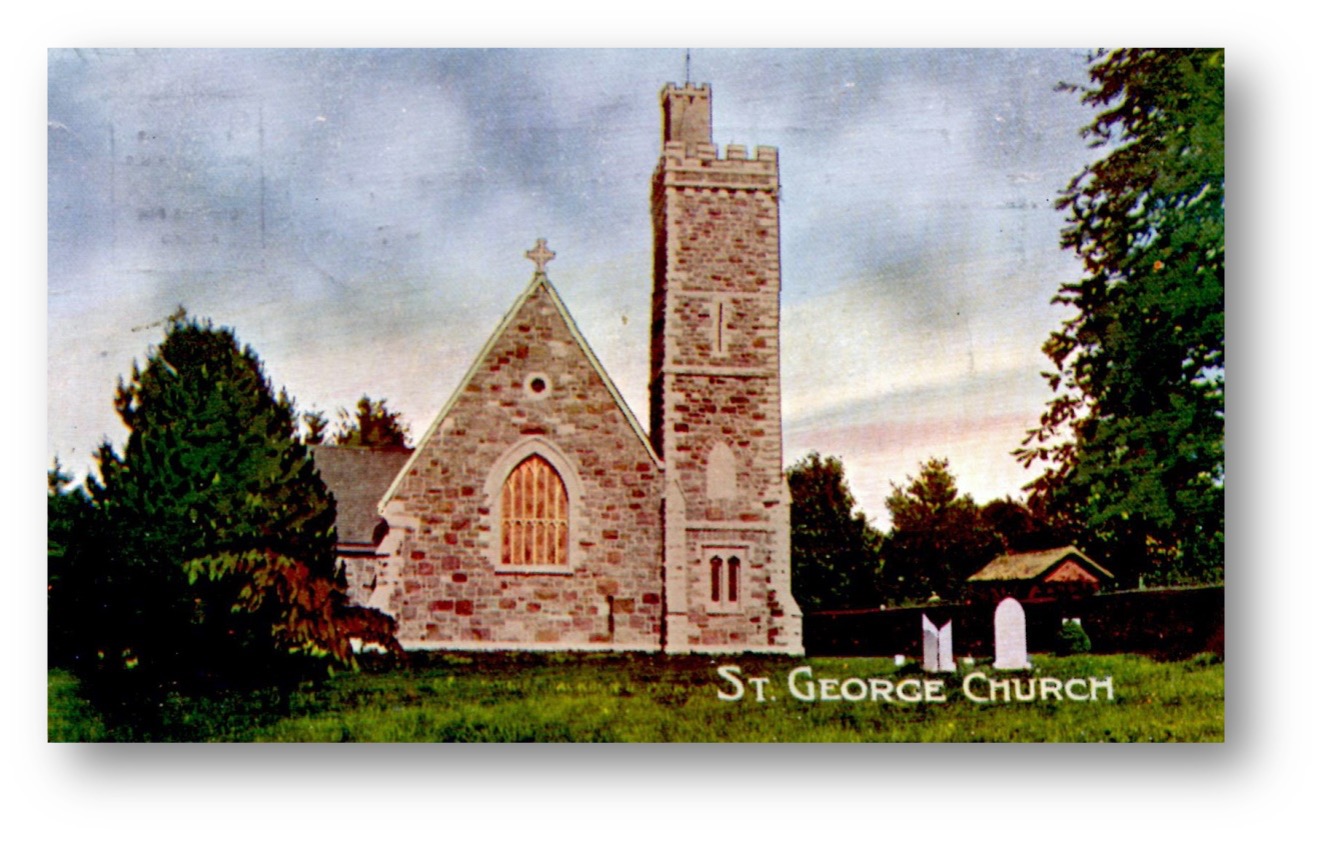
The Church
Enter the St. George’s Church property through the lych (1878) gate. A typical English country church provides this roofed gateway to a churchyard.
This church, built in Gothic style in 1876-7, replaced the original wooden church built in 1839. The stone church architects were Gavillais and Thompson of Barrie, Ontario. Captain Tom Sibbald supervised the building of the church and local craftsmen did the actual building.
Church Interior
The east window above the Communion Table was hand painted in England by some of the daughters of Governor Simcoe. Elizabeth Simcoe, the mother of the girls, and Susan Sibbald were friends from their schooldays. the window was first installed in the original St. George’s in 1845, then was carefully moved into the new church. The side windows are stencilled and painted.
The gilded wooden Celtic Cross on the altar was given by the Rev. Harold McCausland, rector from 1920-23. This cross was used by Mr. McCausland during his chaplaincy services in World War 1. Originally it was part of the processional cross (1850s) of St. Philip’s Church, London, England.
The west window shows the triumphant figure of St. George slaying the dragon, representing the victory of right over might, symbolic of the overthrow of tyranny. It is dedicated to the memory of Lt. G.J. Brichta, RFC, killed over France in 1917, and his son, W/O Philip S. Brichta, killed over Germany in 1943. The silver-cross wife and mother was Anne Mossington, a descendant of an original pioneer family. The window also remembers Philip’s friend and fellow aviator, J.D.B. Ulrichsen, listed missing in action in 1943. He was a nephew of Stephen Leacock.
The vestibule window was given in memory of Mazo de la Roche, Canadian novelist. It depicts St. Francis of Assisi, representing the theme of our responsibility to protect and preserve God’s creatures.
The memorial brasses found on the interior walls are a traditional way of remembering members of the congregation who have passed away.
The Rev. George Everest designed and carved the altar, pulpit, reading desk and hymn board. A local artisan, we believe a Mr. Ward, did the other carvings. The wheat and grapes pattern reminds us of the comfort of Holy Communion.
The cast iron work at the end of the pews represents an art form of the period in which the church was built. Pew 19 was where Stephen Leacock, as a boy, worshipped with his family.
The Christening Font is found in the corner opposite the entrance. This location near the entrance of the church symbolizes the beginning of Christian life through baptism.
The hangings on the altar change with the Christian seasons. The red hangings used on Pentecost, Saints Days and Anniversaries, are the oldest hangings and were probably made in the late 19th century.
Church Exterior
In 1944-49 the tower was rebuilt and reduced in height because of structural deterioration. The original weather vane and base had been previously removed. The gargoyles are a symbols of evil being expelled by the Gospel. The gargoyles (in this case rams’ heads) are used as water spouts.
The cross on the west roof peak is a Celtic Cross which has a circle to signify eternity.
The Bourchier memorials are built into the north side of the church. They were placed there when the stone church was erected over part of the original cemetery. Captain William Bourchier was an original land grantee in the area in 1819. He contributed lumber to build the 1839 original church.
Today St. George’s and its picturesque grounds continue to serve as a spiritual, historical and cultural centre for the community. Visitors are welcome at all services. Visitors are also invited to sit in silence, to pray and to use the prayer desk book to request prayers.
***
Editor’s note: The following information on St. George’s Church was excerpted from an article previously published in a November-December issue of Lake Simcoe Living entitled “Lake Simcoe’s Historic Churches” by Val Pring and found online at the following location:
https://www.lakesimcoeliving.com/blog/great-days-out/lake-simcoes-historic-churches.html?tmpl=component&print=1&format=print
St. Georges Anglican Church, Sibbald Point
St George’s Anglican Church was built in 1876 on Hedge Road at Sibbald Point, just outside Sutton. This majestic building stands high on the bluff at Sibbald Point, overlooking Lake Simcoe. From a stone bench outside the church, you can gaze towards the northwest and feel the vastness of Lake Simcoe.

It is no wonder that Susan Sibbald chose this location for a church constructed as a tribute to Susan Sibbald by her three devoted sons, Capt. Thomas, Hugh, and Dr. Frank Sibbald, this stunningly beautiful church was built to stand the test of time. Every granite stone was hand-picked and checked for iron deposits by Capt. Sibbald. So keen was his eye for perfection that of the whole church, only one stone was missed; located on the west wall, it now weeps brown with rust. A navy man to the core, he modelled his style of leadership after life at sea. Capt. Thomas demanded his workers salute when greeting him, and respond to his requests with “Aye, aye, sir.” Each morning as the eighth bell tolled, Capt. Thomas would administer to his work crew a traditional daily ration of rum, followed by a toast to Queen Victoria — pure navy style!
The strength that Susan Sibbald possessed is echoed in the design and beauty of St. Georges Church. A truly remarkable woman, she was born to upper-class society and lived in a stately manor with her husband in Scotland. She was a forward thinking woman for her time being well educated and travelled. Although quite liberated in many of her views, she was still privy to the social protocols that befit her stature in society. In 1835, at age 52, she came to Orillia to check up on her two sons, whom she had heard through gossip were living in a tavern. Susan’s sons were in Orillia studying horticultural methods for Upper Canada. After satisfying her worries that her sons weren’t becoming victims of alcohol, she took a boat ride around the lake in hopes of purchasing property. It was then that she came upon Penn Rains, located at the current site of Sibbald Point Provincial Park. This small, one-storey building surrounded by wilderness overwhelmed her with its beauty. With visions of transforming it into a gentile working farm, she purchased the property. By the time she returned to Scotland, her husband had passed away, so she sold her estate and brought her children and possessions to start a new life in Upper Canada.
As a devoted Christian, one of her first priorities was to establish a church and school. Using all her wealthy influential contacts, Susan Sibbald raised money from England to create a church made from logs with plaster interior walls. The church building served the needs of the pioneering community that surrounded it. Its construction was a testimony to the determination and discipline of Susan Sibbald. After her death, the old log church was moved on rollers to a spot closer to the lake while St. George’s was being built as a way to ensure the continuation of church services. The beautiful, stained glass windows from behind the alter — designed and painted in exquisite detail by the daughters of Gov. John Graves Simcoe — were carefully moved from the log church and placed in St. George’s. Susan’s granddaughter, who married Rev. George Everest, a descendant of Sir George Everest (famous for surveying Mt. Everest), donated endless hours carving many of the decorative wooden wild grape motifs inside the church. The carvings represent the abundance of wild grapes found growing on the grounds. In the grave yard, great Canadian writers Mazo de la Roche and Stephen Leacock are laid to rest.
parishofgeorgina.org
North Gwillimbury – 1885
The following description of North Gwillimbury Township in 1885 was gleaned from the History of Toronto and County of York, Volume I, pages 166 to 169 published by C. Blackett Robinson, Publisher in 1885.
The early records of the township show that in 1821 the number of the inhabitants of North Gwillimbury and Georgina was 272. In 1822 the population of the two townships had increased to 314 in 1823 it was 339. North Gwillimbury, in 1842, contained 697 inhabitants in 1850 the number was 1,172. The census of 1871 showed a population of 2,304, which, as in most of the townships, has fallen off somewhat during the last decade, the census of 1881 giving the number as 2,151. Of this number 1,869 are of Canadian birth.
The agricultural products of 1849 included 26,000 bushels of wheat,13,000 bushels of oats, 5,000 bushels of peas, 13,000 bushels of potatoes, and 10,000 bushels of turnips. In 1881 the yield amounted to 53,168 bushels of wheat, 22,921 bushels of barley, 76,720 bushels of oats, 20,843 bushels of peas and beans, 24,367 bushels of potatoes, 26,833 bushels of turnips, and 2,692 tons of hay. The occupiers of land number 335, of whom 224 own the soil, the total area in occupation being 28,783 acres, of which 19,106 acres are improved land. The area devoted to field crops is 14,763 acres, 3,826 acres being pasture, and 517 gardens and orchards.
The townships of North Gwillimbury and Georgina were united for some time. The officials for the united townships for 1822 were as follows: Arad Smalley, town clerk; Holland A. Payson and Alexander Lawson, assessors; Joshua Utler, collector; Erastus Smalley, Asa Crittenden, George Williams, Daniel Mann, Zenas Hentley, Fountain D. Hunter, and William Carter, path-masters; Silas Ernes and L. Hale, pound-keepers; William Crittenden and Joseph Lile, town wardens. In 1823 Arad Smalley was town clerk; Asa Smalley and Benjamin Jefferson, assessors; H. H. Payson, collector, and Joel Draper and Simeon Martin, town wardens. The town wardens for 1824 were Jacob Draper and J. Donald; for 1825, John Comer and Squire Martin. In 1826 the Township of Georgina was separated from North Gwillimbury, and the record of municipal proceedings thenceforward relates to the latter township only.
In 1827 Joel Draper and David Mann were town wardens; Silas Ernes, assessor; John Prossor, collector, and Arad Smalley, town clerk. In 1828 David Sprague became township clerk, an office which he retained until 1842. James Crittenden and Ephraim W. Payson were town wardens for the former year. The town wardens for some years following were as follows: 1829 David Sprague and Noah Gager; 1830 Joseph Rose and Martin Warmer ; 1831 J. Rose and Squire Martin; 1832 Abraham Sedore and Austin Huntley; 1833 N. Gager and Joel Draper; 1834 Silas Ernes and Israel Bennett; 1835 J. Ross and E. Willoughby. In 1836 the municipal system underwent some changes. D. Sprague, B. W. Smith, John Prossor and Justin Hatfield were chosen commissioners. In 1837 the commissioners were Justin Hatfield, Isaac Bennett and Peter Bilder. A memorandum dated 1st of January, 1838, is as follows: “In consequence of the Rebellion which broke out on the 4th of last December no township meeting took place this day. The township officers of last year therefore remain in their various offices during the year. David Sprague, town clerk.”
The records contain a minute of a special session of the magistrates for the division of North Gwillimbury and Georgina, held at North Gwillimbury on the i6th April, 1838, bearing the signatures of Arad Smalley, J.P., and Thomas Mossington, J.P. In 1839 Oliver Barton, N. Gager, and D. Sprague, sen r, were town wardens. There was another special session of magistrates of the two townships this year at which Arad Smalley, James D. Boucher, of Georgina, Thomas Mossington, and Simon Lee were present.
In 1840 the town wardens were Silas Ernes, J. Bennett, and G. D. Earl; in 1841, D. Sprague, sen r, and George D. Earl ; 1842, J. Carbett, Silas Ernes, and George W. Chipperfield. In this year David Dawson was appointed town clerk in place of Mr. Sprague, and retained the position until his death, in 1846, when Mr. Sprague was again chosen to the office. The town wardens for 1843 were G. D. Earl, G. Chipperfield, and J. Bennett. In 1844 the Home District Council was organized, Isaac Bennett being chosen councilman for the township. The town wardens for this year were, G. W. Chipperfield, N. Gager, and D. Sprague senior. The town wardens for the remaining years during which this office existed were as follows: 1845 H. Huntly, Austin Huntly, Simeon Huntly: 1846 T. Mossington, Israel Shepherd, J. Chipperfield; 1847 Cornelius Silver, William L. T. Corbett, G. D. Earl; 1848 John Prossor, Hugh H. Wilson, Silas Ernes; 1849 Nicholas Bennett, Robert Anderson, S. Sprague senior.
In 1850 it is recorded that the first meeting of the municipal council of the township took place on the 22nd of January, at Dughill school house. Isaac Bennett being reeve, and Messrs. J. Prossor, Arad Shepherd, J. Morton, and D. Sprague, councillors, and Richard Sheppard, township clerk. Thomas Mossington became reeve the following year. In 185.2 John Prosser was elected to the reeveship. He was succeeded in 1853 by David Sprague, who held the office for two years. He subsequently held the same position in 1856, 1858, and 1864. In 1855 and 1862 the reeveship fell to John Morton, and in 1857 to D. B. Wilson. Thomas Evans filled the chair in 1859 and again in 1861, William Henry in 1860 and 1865, Henry Draper in 1863 and subsequently for the period 1866-69. In 1870 he was succeeded by John Marritt who had a five years term, and filled the position again in 1876. Elijah Prossor and Willard Bennett are also among those who have held the office of late years. The present reeve is R. M. Van Norman of Keswick, the deputy-reeve being D. H. Sprague of the same place. The other councillors are Stephen Winch and J. D. Davidson, both of Belhaven, and John Boag, of Ravenshoe. Henry Sennett, Belhaven, is township clerk ; E. Nosser, of Keswick, treasurer, and Ellis Sheppard, of Belhaven, assessor.
The township meetings, for some fifteen years past, have been held at Belhaven, a village containing about a hundred inhabitants, occupying a central position in the township. Keswick, originally called Medina, is picturesquely located on the summit of the uplands, overlooking Cooke’s Bay to the west. The population is about one hundred and sixty. Three miles to the north is the village of Roach s Point, on the headland which forms the northern limit of Cooke s Bay, the romantic situation and surroundings of which have not availed to induce its growth. It was formerly known as “Keswick” but lost its official designation when the post-office was removed to the lower village. A mile and a half south of Keswick is Jersey. The three villages are connected by a road following the course of the elevated land along the coast. Another road (Catering Road) strikes across the township in a north-easterly direction from Ravenshoe in East Gwillimbury. This was the outlet of travel to Yonge Street in the early days of settlement.
The Lake Simcoe Junction Railway traverses the township from south to north within a very short distance of its eastern boundary. North Gwillimbury contains seven school sections, and seven teachers. No. 1 is half a mile east of Queen Street, and on the first side-road north from the town-line south. It is a plank or frame building of considerable age, and not so comfortable as recent improvements have made pretty general. The average attendance under the present teacher, Miss Sarah Earl, is 35. No. 2 is also on Queen Street, five miles north of the town-line, and half a mile north of Keswick, or Dug Hill. The house is a rough-cast frame of good size and comfort. The average attendance is 33; teacher, J. E. Pollock. No. 3 is situated on the base-line, two miles directly west of Sutton, and one and a half from Lake Simcoe. The house is an old plank or frame, with some recent improvements and good furniture. The average attendance is 32; the teacher, Miss T. Price. No. 4 is nearly in the centre of the township, on the farm of John Morton, Esq., lot 18, 5th concession, and is an old frame house fairly furnished and kept; average attendance, 41; teacher, Miss Sarah Fisher. No. 5 is on the south-east corner of lot 6 in the 5th concession in the English Settlement. It is an old frame building, with a recent addition to make legal space for the school population, but not comfortable or attractive inside. Miss Thusnelda Borugasser is the teacher. Her average attendance is 40. No. 6, or Roach s Point School, is an old frame house on the base-line, about six miles west from Sutton, on lot 23, 3rd concession. The average attendance under the present teacher, Miss Jennie Rogers, is 20. No. 7, known as Gum Swamp School, is situated on lot 15, 7th concession. The building is a neat and comfortable frame building erected in 1882. Miss Mossie Sheppard is the teacher. The average attendance is 18.
The Railroad Gauge
Shared from an e-mail received a few days ago and worth repeating…a little humorous tongue-in-cheek railway history the accuracy of which only a few historians dispute…the e-mail gave no source of origin or authorship.
The Canadian and U.S. Standard railroad gauge (distance between the rails) is 4 feet, 8.5 inches. That is an exceedingly odd number. Why was that gauge used? Because that’s the way they built them in England, and English expatriates designed the Canadian and U.S. Railroads. Why did the English build them like that? Because the first rail lines were built by the same people who built the pre-railroad tramways, and that’s the gauge they used. Why did ‘they’ use that gauge then? Because the people who built the tramways used the same jigs and tools that they used for building wagons, which used that wheel spacing.
Why did the wagons have that particular odd wheel spacing? Well, if they tried to use any other spacing, the wagon wheels would break on some of the old, long distance roads in England, because that’s the spacing of the wheel ruts. So, who built those old rutted roads? Imperial Rome built the first long distance roads in Europe (including England) for their Legions. Those roads have been used ever since. And the ruts in the roads? Roman war chariots formed the initial ruts, which everyone else had to match for fear of destroying their wagon wheels. Since the chariots were made for Imperial Rome, they were all alike in the matter of wheel spacing. Therefore, the Canadian and United States standard railroad gauge of 4 feet, 8.5 inches is derived from the original specifications for an Imperial Roman chariot. In other words, bureaucracies live forever.
So the next time you are handed a specification, procedure, or process, and wonder, “What horse’s ass came up with this?”, you may be exactly right! Imperial Roman army chariots were made just wide enough to accommodate the rear ends of two war horses…
Now the twist to this story: When you see a Space Shuttle sitting on its launch pad, you will notice that there are two booster rockets attached to the sides of the main fuel tank. These are solid rocket boosters, or SRBs. The SRBs are made by Thiokol at their factory in Utah. The engineers who designed the SRBs would have preferred to make them a bit larger, but the SRBs had to be shipped by train from the factory to the launch site. The railroad line from the factory happens to run through a tunnel in the mountains and the SRBs had to fit through that tunnel. The tunnel is slightly wider than the railroad track, and the railroad track, as you now know, is about as wide as two horses’ asses.
So, a major Space Shuttle design feature of what is arguably the world’s most advanced transportation system was determined over two thousand years ago by the width of a horse’s ass… And you thought being a horse’s ass wasn’t important!!
Early Images of Georgina
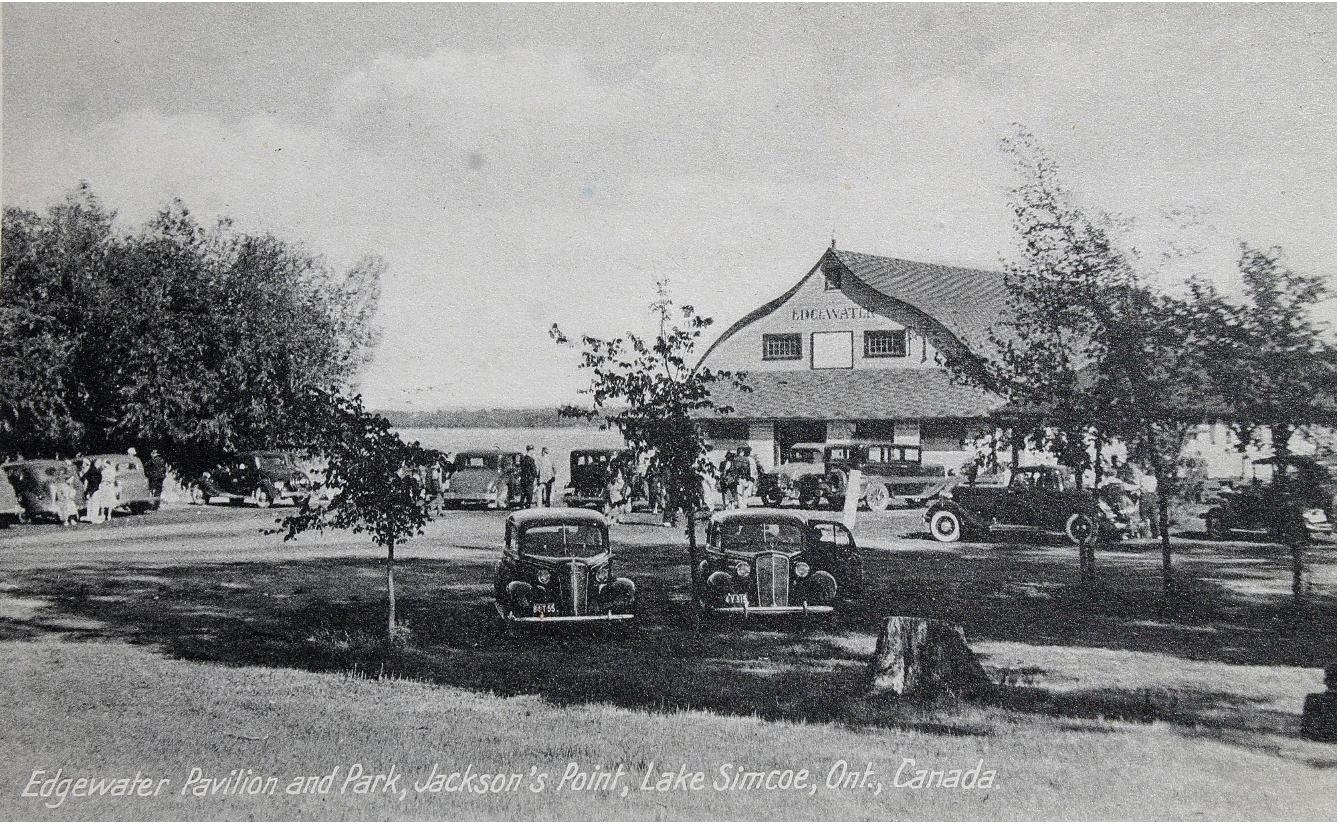
Above is an early image of the Edgewater Pavilion, Jackson’s Point Ontario.
Where in Georgina?
Can you identify the location and name of the mystery location to the left?
We’ve had no response as yet on this one!
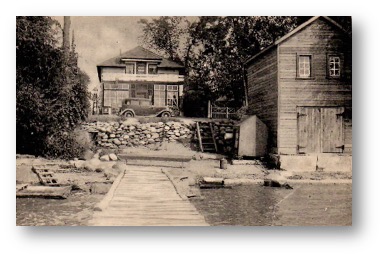
Our Pioneer Ancestors
WALTER S. RAE, lot 13, concession 6, was born in the Township of Georgina in the year 1833, being the son of John Rae, who emigrated from Scotland. In the early days of settlement Mr. Rae tells us that the only road in the township was the one leading from Sutton to Beaverton. The school-house was a small log-building, although teaching was mostly done on the “boarding out” system, the payment being twenty-five cents per month for each scholar. Mr. Rae was married in the year 1866 to Selina Honey, who was born in England ; they have a family of three children. Mr. Rae, by economy and perseverance, has got together a comfortable home.*
*Excerpted from: History of Toronto and County of York, Volume II; C. Blackett Robinson, Publisher 1885, pp. 510-511.
News
Our President, Paul Brady, has reached out to other historical societies to learn how they have dealt with the issue of neglected early cemeteries in their municipalities, an issue we have raised in the past. We have received a response from Janine Harris-Wheatley, President of the Tecumseth and West Gwillimbury Historical Society. Her husband Vaughan Harris is Chair of the Cemetery Guardians, a group jointly supported by TWGHS and the Bradford West Gwillimbury Local History Association.
In her reply to us, Ms. Harris-Wheatley advised “Six years ago we began restoration work on Wilson’s Hill, an inactive heritage cemetery in BWG (Bradford West Gwillimbury) — with the Town’s permission. In 2021 this project received the Ontario Historical Society’s Cemetery Preservation Award. Since then we have also worked on Christ Church Cemetery and the Auld Kirk Cemetery. We are adding three more inactive heritage cemeteries in BWG to the work list for the Spring.”
“When one of our members shared the article below, we thought it might be helpful to invite members of the GHS, perhaps also Mr. Prosser, and someone at the Town for a guided tour of Wilson’s Hill, (and possibly also Christ Church and Auld Kirk depending on time). We could show you what volunteers can accomplish restoring the landscape, gravestones, and, with some money for professional services, the monuments, in a cemetery that was once in a similar state to what was reported about the Mann Cemetery. This would be in the spring when the ground is defrosted and drained so the Hill is easier to climb.”
The article Ms. Harris-Wheatley refers to is found at:
https://www.yorkregion.com/news-story/10841706–it-s-not-proper-georgina-historical-cemetery-in-disrepair-gravestones-found-sideways-upside-down-/?s=n1?source=newsletter&utm_content=a03&utm_source=ml_nl&utm_medium=email&utm_email=05D7E34BFA603E070E35B65EFAE96AA2&utm_campaign=yrha_145176 (control + mouse-click to see article)
Ms. Harris-Wheatley further advises “BWG (Bradford West Gwillimbury) has always recognized its legal responsibility under the Ontario Funeral, Burial, and Cremation Services Act, to ‘maintain’ the inactive cemeteries, but only to the extent that they hire a company to whip around the stones on grass cutters as if they were parks — for far too many cuts each summer.” Sounds familiar? She goes on to say, “Now that we are getting positive responses from the public — and the Award certainly helped — they have done more, such as bringing in a crew to cut down and remove dead trees, hiring a professional company to repair six of the monuments in two of the heritage cemeteries (the dangerous work), trucking in gravel for our crew to raise the fallen stones, and replacing one of the fences that had become unsafe. We have never had a discussion about liability and the Town encourages volunteer work.”
“My husband sends in at least one report a year to the Parks and Rec Director. Myself and the BWGLHA (Bradford West Gwillimbury Local History Association) President have sent the occasional letter to Council about the damage from the grass cutting to trees and stones. I am always careful to refer to the cemeteries as “sacred places”, which they are. We should not disrespect ancestors, whether indigenous or settlers. We have met yearly with the CAO and Parks and Rec Director and last time they asked my husband to review and report on the other inactive cemeteries so now he and the crew are taking on three more this summer that need varying amounts of attention. It can be quite hard work but it keeps them fit.”
Your GHS has raised this issue in the past with articles in earlier issues of this newsletter. This sounds like a possible solution to the neglect at the Mann Cemetery and others in Georgina. We could use a volunteer group like the Cemetery Guardians here! If you are interested in this as a possible solution, join with us; contact Paul Brady or a Board member to volunteer your time and help us resolve this problem.
We’ve now enjoyed use of the schoolhouse for several Board meetings and meetings for the general membership. As the schoolhouse does not have a kitchen, coffee and tea cannot not be available. But, please feel free to “lug a mug” of your preferred refreshment…we’ll provide some snacks and water. We’re looking forward to seeing you.
There’s lots happening at the village. New and exciting programs and workshops are being offered all year long. Save this link to your desktop and check back regularly for updates. Or follow Georgina Pioneer Village social media channels to keep up to date (on Twitter and Instagram, or ‘Like’ them on Facebook).
For educators and clubs, group programming is offered from Sept to May. Also back by popular demand is the exclusive Rise to Rebellion, a live re-creation of the 1837 Rebellion of Upper Canada annually in May. When the buildings are closed, the village is always open for a stroll. Download the self guided tour on your computer or on your mobile device to learn as you stroll.
For more information regarding the above programming or renting the village for meetings, birthday parties, weddings, photo shoots or events, please visit Georgina Pioneer Village & Archives or email curator@georgina.ca

Events
April 18th – Members meeting, guest speaker Lynda Quirino of the Georgina Paranormal Society will speak at the new schoolhouse at Georgina Pioneer Village,
September 16th – tentative date set for Harvestfest; more to come later.
